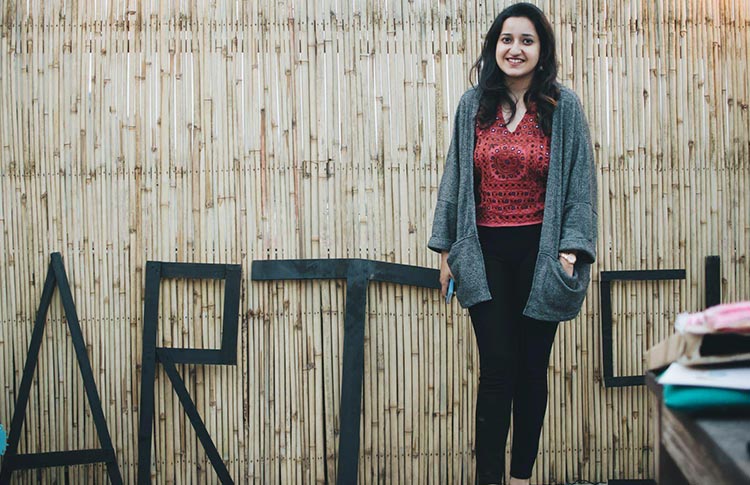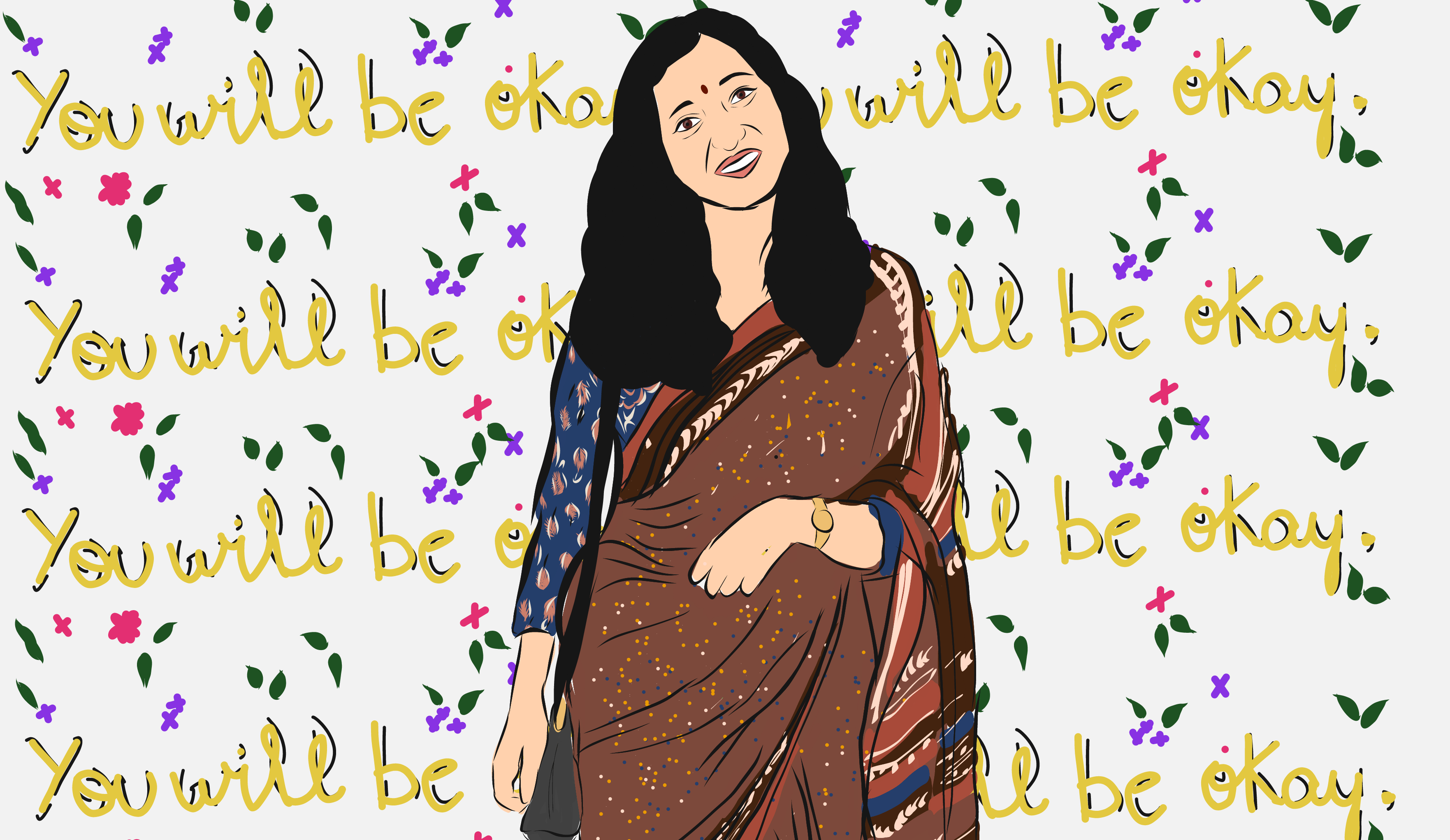‘You will be okay’—these four words are spray painted on a pink wall on the outer ring road of Hauz Khas, Delhi. This fragile reassurance is written in a soft blue color accompanied with two yellow flowers and is tucked between two faded red obtrusion on the wall. It is an obvious message about hope which provides you with the comfort of familiarity in chaos and conflict. In this enormous city full of moss-filled ponds in soft green gardens, temples and mosques, sturdy and grainy monuments in a pool of urban decay, art galleries and the spirit of whoever grew up in its veiny lanes and arms—this graffiti is what sums up the amalgamation of the disquiet of this big and bustling crock pot of a city. This artwork was made by Isha Yadav along with Ali Monis Naqvi in 2017. The same graffiti is made on a wall in Shahpur Jat. They painted these signages on ten walls under an art project called ‘Art touch lives’ to provide people with mental and emotional support.
I remember being mesmerised after reading the line, “I want to yell, it’s burning my nerves, my blood, slowly ashening my skin and I must put the fire away because how dare I be a girl and not pretty.” on Terribly Tiny Tales’ post. I dug up the fierce poet who penned what I felt in better words, than I could ever have. I read, imbibed and devoured her poetry. The short poems/prose she has written, especially ‘Blood Boils’ are fabricated from the thread of experience. Her words dwell in the lap of relatability for young Indian women because they are so curt and neat they strike as a stroke of cleverness mixed with reality.
If you happen to open her Instagram account, you’ll see her painting portraits of women, mastering the art of whipping up cool desserts like blueberry delight and dawning floral prints. She has worked as an Assistant Professor at the University of Delhi and is currently pursuing a PhD in Women and Gender Studies from Ambedkar University, Delhi.
That poet is Isha Yadav who is also a feminist writer, mental health activist, street artist and an educator. If you happen to open her Instagram account, you’ll see her painting portraits of women, mastering the art of whipping up cool desserts like blueberry delight and dawning floral prints. She has worked as an Assistant Professor at the University of Delhi and is currently pursuing a PhD in Women and Gender Studies from Ambedkar University, Delhi. In 2017, she wrote subtitles for a film, ‘All I Want’ which went on to win the best short film at Cannes Film festival. She has judged various poetry competitions. And she spoke at a symposium in New York University on ‘Queering Art History’.

She founded the very first platform for slam poetry in Delhi called, ‘Delhi Poetry Slam‘ which invites poets from all walks of life to participate, grow and flourish. She also started ‘Periodlogue’ which started as a WhatsApp group for people who menstruate. It was a closed community to talk to about what can provide comfort during menstruation, the stigma around it and casual sexism in everyday life. She also collaborated with The Education Tree to work on a project called, ‘Humans of anxiety’ to arm people with the awareness about mental illness and its tolls. Currently, she’s working on documenting rape threats that women receive on a routine basis. Her project is called, ‘Museum of rape threats’.
Her poetry is an amalgamation of what’s around her. She writes in response to what’s being done by patriarchy(mostly)—because this structure harms people in a way that can make them redundant. Her artwork includes portraits and bodies of women. She talks about South Asian tendencies, how they are viewed and the intricacies of their lives. She isn’t a trained artist but she does layered work on acrylics, watercolor and pens. She believes that conversations and thoughts are of primary importance, and skills and aesthetics can be compromised but the conversation should go on. Here is a short interview of Isha Yadav.
Also read: Dalit Art: An Endeavour In Exploring Notions Of Caste Boundaries
Q1. Your art mostly has an abundance of dialogue, it seems like it’s responsive and very assertive. What do you think culminates to inspire you to make such art?
Isha Yadav: I’ve been drawn to want to create discomfort, or urgent need for conversations. For example, art about periods, bleeding women bodies, thinking and anxious women bodies, ways in which women be and express themselves. For a project, I looked at stories of arranged marriages in India and illustrated them (project on hold right now), and currently I’m working on a series of paintings that talk about how women in family guard patriarchy and hurt each other. It’s called ‘This is What Buaji Said’. Visuals are a striking and important source of learning, and with most of our social media appetite, I think they work wonders for drawing attention to the cause. I work at the intersection of art and gender and am constantly working on ways where intricacies of our gendered experiences are expressed through art.
Q2. The art and the artist will always be linked together. What are your views about this statement?
Isha Yadav: I think this is a paradox that all of us are still getting our heads around. We have seen what happens when you separate the two, and when you don’t separate the two. In reference to J.K. Rowling’s transphobic tweets, her contribution to children literature and magic realism is insurmountable but she’s been unfair and has invalidated the struggles of the trans community. Do we hold Harry Potters by the neck or do we separate? If we separate the two, the artists can create scot-free, and if we don’t we miss out on some of the greatest inventions and creations of the world. How to accommodate a flawed artist is a massive issue for our times and we’re all here learning to thread out the complicated truths.
I think this is a paradox that all of us are still getting our heads around. We have seen what happens when you separate the two, and when you don’t separate the two. In reference to J.K. Rowling’s transphobic tweets, her contribution to children literature and magic realism is insurmountable but she’s been unfair and has invalidated the struggles of the trans community.
Q3. How essential do you think is the awareness of mental health activism for today’s artists/poets/thinkers/writers?
Isha Yadav: Absolutely essential. I completely give the credit of the conversations and all the work around mental health that we’re doing right now, to artists, poets and writers. They’ve humanized our human lives and taken it out of the taboos, and I’m grateful to these creators every single day for inspiring, encouraging and supporting a number of people to seek support, find strength and heal. I want to implore more artists to take the conversation further from where we have reached today, teach more people, include more people and solidify the activism around mental health. I think the onus of this task is on us, especially when we know that the previous generations have only suffered in ignorance and silence.
Yadav’s project on arranged marriages in India invited stories from women who were in an arranged marriage or were due for one. The project mostly looked at raw opinions. It was an attempt to understand this institution from the lens of the current generation translated into art. Most stories that emerged out of this project talked about tricks to keep a marriage working, the matchmaker aunties who snoop and the insecurities which slide in when your parents tumble you down this road of meetings, insecurities, rejections and sometimes acceptance. Isha paints the everyday woman out in the world juggling responsibilities and duties, being vulnerable and becoming stronger.
Another project that Isha is working on currently is the museum of rape threats. When women exhibit their views or try to stand up for something the first threat they receive is that they’ll be sexually harassed. There has been a huge increase in the cases of verbal violence towards women. The only threat women are given in any situation is, ‘koi rape karke chala jayega toh tum kya karogi?‘ As if saying this isn’t bad enough. To create a digital installation of such comments and messages, Isha started this Instagram page which documents such violence.
Also read: Ashmina Ranjit: Finding Flight, Freedom And Change Through Art
Through the bloody canvases and thick ochre skin of the women in her portraits, Isha paints fearlessness, courage and hope. Through the fragility of triviality of heartbreak poems, she finds her way into the hearts of the many women who are the women in her portraits and the point-of-view of her poems. It is the reality of the uncomfortable conversations which drive her to paint more and write more, and she does all that with a sprinkle of hope on top.
Featured Image Source: Artwork by Author
About the author(s)
Aamna is an impulsive writer who is studying and falling in love with English literature. She is learning, unlearning and relearning herself and the world around her every single day. She loves painting and believes that she is the daughter of post modernism.




